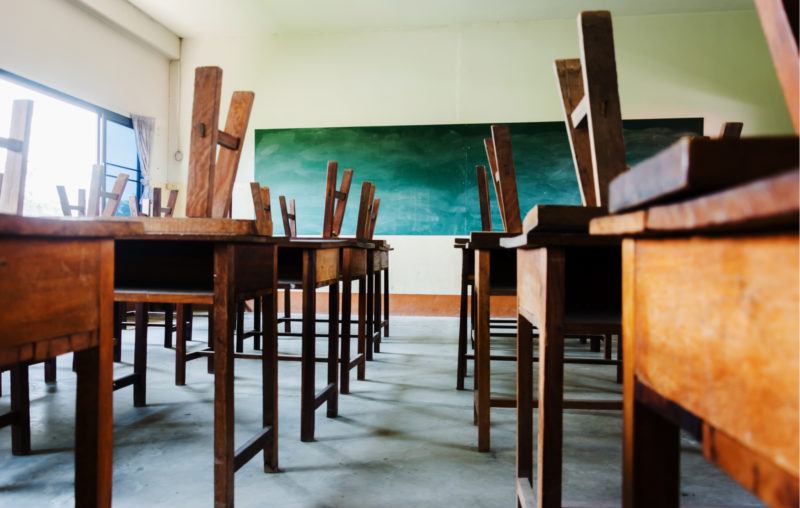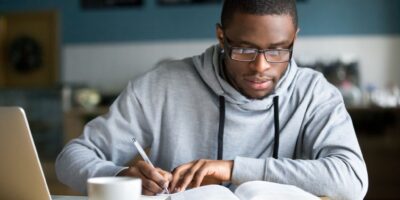The Dangers of Keeping the Schools Closed

As the school year approaches, there is much consideration over whether or not to close the K-12 system in an effort to slow the spread of COVID-19. These concerns come from a wide variety of constituencies, from parents to public officials to teachers. However, much like the overall discussion regarding COVID-19, this proposal is ill-informed and will likely lead to unintended consequences that will be far more severe than the problem it seeks to address.
School Closures Are a Time-Sensitive Policy
One of the first points to consider when approaching the question of closing schools is timing. Yale University sociologist Nicholas Christakis, a proponent of school closure, warns that although the policy could be beneficial it must be done very early. Furthermore, although Dr. Christakis certainly supports school closure if done at the correct time, he acknowledges that now
“It’s sort of closing the barn door after the cow is gone.”
This maneuver, even for those that support it, will be incredibly difficult to do effectively and the appropriate time to even consider this policy may well have been in January, not July.
It also seems that proponents of school closure seem to misunderstand the purpose of their proposal. Italian epidemiologist Marco Ajelli tells NPR
“Closing schools can buy time and delay the peak of an epidemic.”
Unfortunately, that time has passed as well. Much like anything concerning COVID-19 and epidemiology, we cannot be certain that closing schools will actually delay the peak of an epidemic. Even if it is an effective policy measure, school closures are not intended for simply reducing cases amongst children; they are a way to buy time to prepare for the climax of an outbreak.
As outlined by Dr. Christakis’s sentiments, the time for this conversation should have been months ago. It may have been an effective policy to buy time for hospitals to retool and prepare for the outbreak but that has since been accomplished, although rather sloppily. The peak of the pandemic has passed, COVID-related deaths have dramatically decreased, and hospitals are far more prepared than they were months ago.
Closing Schools May Hurt Children More Than It Protects Them From COVID-19
When it comes to protecting the health of children, sending them to school could possibly be the safest option. Sonja Santelises, CEO of Baltimore Public Schools tells NPR that
“For a large number of our students, the safest place for them to be is actually in school.”
Schools provide a number of things that would be advantageous to the well-being of a child. Being at school places children in a controlled environment which in some neighborhoods could be better for more problems besides infection control.
Children are the least vulnerable to COVID-19. Professor Peter Collignon, an Australian microbiologist and infectious disease physician, writes in the Guardian
“The data from a range of countries shows that children rarely, and in many countries never, have died from this infection. Children appear to get infected at a much lower rate than those who are older… there is no evidence that children are important in transmitting the disease.”
Furthermore, a paper published by medical experts at Colorado State University and Yale University says that
“What we know about social distancing policies is based largely on models of influenza, where children are a vulnerable group. However, preliminary data on COVID-19 suggests that children are a small fraction of cases and may be less vulnerable than older adults.”
The Atlantic offers some additional insight on why children seem to be at a lower risk of contracting COVID-19 as they report
“Everything an infant sees, or a young child sees, is new,” says Donna Farber, an immunologist at Columbia University. Thus, their immune system is primed to fight new pathogens in a number of ways… This is why adults are able to mount a rapid immune response to previously encountered pathogens, but also why they might have trouble fighting a new one. Diseases such as rubella and chicken pox are also, for various reasons, more severe in adults than in children.”
The CDC echos this assertion that children are at a lower risk of COVID-19 not only in the mortality rate which is extremely rare but also in the infection rate. Furthermore, online teaching in its current state would not deliver the same results as an in-person experience. If schools intend to stay closed for any substantial amount of time that could be incredibly detrimental for young students.
Professor Collignon writes
“Many will likely miss out on over six months of teaching. While online learning might be available it is unlikely to be as effective as face-to-face teaching and those with less resources will disproportionately be disadvantaged. Minimal or no mixing with their friends and other children for over six months will also have deleterious effects.”
Many teachers will have little to no aptitude for effectively running online classes. Disadvantaged students such as those with troubled families or low socioeconomic status will be most harmed by school closure. In particular, many parents will need to take time off from work to care for their children. For many, this would be impossible.
Childcare Obligations Will Decrease the Effectiveness of the Healthcare Sector And Potentially Increase Deaths
When considering the childcare needs of healthcare workers, closing schools may actually lead to an increase in mortality rates not just for COVID patients but sick individuals more broadly. Congruent with AIER’s observation that the conversation surrounding COVID-19 seems to be utterly blind to the tradeoffs of lockdown measures, Jude Bayham and Eli Fenichel write
“School closures come with many tradeoffs. Setting aside economic costs, school closures implemented to reduce COVID-19 spread create unintended childcare obligations, which are particularly large in healthcare occupations.”
According to their raw data about 15% of registered nurses, 19.14% of Diagnostic- related technicians and technologists, as well as 14.45% of EMT and paramedics will be unable to meet their childcare obligations with the help of a nonworking adult or sibling just to name a few. Much like all models and calculations, the true percentage of total healthcare professionals that will be forced to take time off from work is not certain. However, what we can be certain about is that closing schools will impose childcare obligations on healthcare workers that will lead to a reduction in the overall medical staff.
The drawbacks of such a decision, the most important being an increase in mortality rates due to lack of medical professionals, can only be estimated with models. These models, much like those used by epidemiologists to predict COVID-19 deaths and spread, must rely on assumed values and equations that seek to imitate reality. As a result, we cannot be certain whether the result will be more or less severe.
We can be certain that closing schools will result in a reduction of medical staff. We can also be certain that this reduction of staff will increase the risk of mortality not just for COVID-19 which is a comparatively mild disease but also for those suffering from even more serious ailments. Whether it will be a slight increase that can be justified by an overall reduction in infections, as some would say, or send catastrophic shockwaves of unintended consequences, much like closing the economy, cannot be reliably predicted at this time.
A paper on epidemiology written by British Healthcare Professionals caution concludes that
“Other implications of school closure (e.g., ethical and economic considerations) and viral properties such as virulence must also be considered in policy decisions.”
It is worth noting that the authors of the paper conclude that school closures would be effective in combating influenza. In the case of COVID-19, in which children are at a lesser risk, it is unclear whether or not school closures would be as helpful in slowing infections. What we can be sure of is that there will be a host of unintended consequences. These include everything from a drop in healthcare staffing to an additional economic disturbance on top of the current financial calamity generated by the lockdowns.
Closing Schools Will Exacerbate Existing Economic Calamity
A report published by the Brookings Institution states that
“We find that closing all schools in the U.S. for four weeks could cost between $10 and $47 billion dollars (sic) (0.1-0.3% of GDP) and lead to a reduction of 6% to 19% in key health care personnel. These should be considered conservative (i.e., low) economic estimates in that earnings rather than total compensation are used to calculate costs.”
This is only assuming schools will be closed for four weeks, not until 2021 which many either advocate or have already done. Much like shutting down the economy and labeling some businesses “nonessential” has unleashed a wide range of predicted as well as unpredicted consequences, we can be sure closing schools will do the same.
Sending children to school has been a basic component of American socioeconomic life for generations. A sudden cessation leaves millions of kids at home in an economic system which is virtually built on the assumption that their parents don’t have to take care of them during the day. We can only imagine how disruptive that would be.
Perhaps one of the most overlooked consequences of closing schools and lockdowns more generally because of its difficulty in measuring is hope. Although we can measure decreases in the healthcare workforce and economic retraction, we can’t easily measure optimism. Right now optimism is critical. A working paper from the University of Chicago estimates that 60% of the current economic downturn is due to consumer sentiments; that is, being afraid of living their lives due to COVID-19.
There will surely be further economic retraction due not only from physically closing schools but a reduction of hope and increased anxiety. The effects will be impossible to measure until they happen. The same goes for increases in suicide rates, domestic violence, substance abuse, and so on. These are further unintended consequences and tradeoffs that have resulted from the lockdowns. It is not absurd to think they will only worsen by closing schools.
Are the Tradeoffs Worth It??
As the 2020-2021 academic year approaches, closing K-12 education and switching to remote learning is on the minds of many. Those who advocate for this decision must come to terms with a number of important tradeoffs that come with it. Some of those tradeoffs are more apparent than others.
Closing schools will certainly be detrimental to the educational and social needs of a generation of children.
For some, school might actually be the safest place to be and for countless working parents they need their kids to be there. More importantly, the healthcare sector needs all hands on deck not only to handle the pandemic but to serve patients with ailments far deadlier than COVID-19.
Forcing healthcare professionals to stay home to take care of their children will likely result in a higher mortality rate. Closing schools will inevitably worsen the economic downturn caused by the existing lockdown in ways that we can only begin to imagine.
Medical experts who support school closures more generally clarify that they are a tool to be considered at the beginning of a pandemic, not seven months in. Lastly, COVID-19 poses a far lesser risk to children for both death and infection. Closing schools will probably spare some schoolchildren from infection. Whether it will be enough to justify what we may have to sacrifice is another question entirely.










